Wind Effects on Mast Arms
(with Drs. Gary Conzolazio and Kurtis Gurley, Civil and Coastal Engineering, University of Florida)
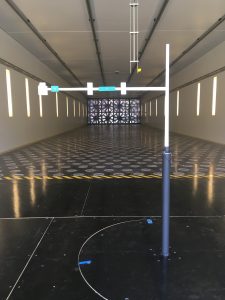 According to the current Florida Department of Transportation (FDOT) design and analysis approach a significant number of mast arm structures across the state are at capacity, i.e. they are unable to support any more traffic signals or signs. Consequently, additional traffic and safety related attachments cannot be added to current mast arms without significant changes to, or replacement of, the structure. Therefore, the objective of this project is to investigate the potential of mast arm structures to have additional capacity without requiring major modifications, or replacement, of the structure. The project is examining two approaches to achieve this goal. The first is by reviewing the current design and analysis approach used by FDOT for unnecessary conservatism. The second is by designing and testing possible hardware modifications to the attachments (signals and signs) in order to decrease aerodynamic drag. Both approaches are being done by placing 3D-printed scale models of nine representative mast arm structures, those most commonly used in the state of Florida, in the Powell Family Structures & Materials Laboratory Boundary Layer Wind Tunnel then gathering data on the wind loads generated at the base of the structure for various configuration of signals and signs.
According to the current Florida Department of Transportation (FDOT) design and analysis approach a significant number of mast arm structures across the state are at capacity, i.e. they are unable to support any more traffic signals or signs. Consequently, additional traffic and safety related attachments cannot be added to current mast arms without significant changes to, or replacement of, the structure. Therefore, the objective of this project is to investigate the potential of mast arm structures to have additional capacity without requiring major modifications, or replacement, of the structure. The project is examining two approaches to achieve this goal. The first is by reviewing the current design and analysis approach used by FDOT for unnecessary conservatism. The second is by designing and testing possible hardware modifications to the attachments (signals and signs) in order to decrease aerodynamic drag. Both approaches are being done by placing 3D-printed scale models of nine representative mast arm structures, those most commonly used in the state of Florida, in the Powell Family Structures & Materials Laboratory Boundary Layer Wind Tunnel then gathering data on the wind loads generated at the base of the structure for various configuration of signals and signs.
Small Unmanned Aerial Vehicles (sUAV) for Structural Inspection
(with Dr. Peter Ifju, Mechanical and Aerospace Engineering, University of Florida)
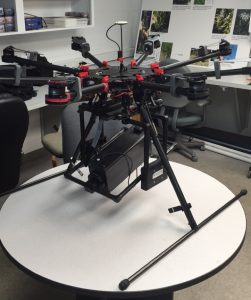 According to a 2013 report by the American Society of Civil Engineers (ASCE), of the 12,070 bridges in the state of Florida, 16.9% are considered either structurally deficient or functionally obsolete. This, however is substantially less than the 24.9% of bridges that fall into either category for the United States as a whole. The Florida Department of Transportation (FDOT) recognizes that part of improving the condition of these bridges is developing more modern methods for performing inspections, which decrease the costs and nuisances involved, while improving the quality of data obtained. The objective of this project is to evaluate the use of sUAV systems for use in structural inspections, with a focus on providing a viable alternative to the use of current under-bridge inspections vehicles (i.e. snoopers). This project will include the optimization of UF’s existing octocopter and the equipped optical and thermal sensors, as well as the assessment of available image processing software and current data storage and reporting methods, in order to meet inspection needs.
According to a 2013 report by the American Society of Civil Engineers (ASCE), of the 12,070 bridges in the state of Florida, 16.9% are considered either structurally deficient or functionally obsolete. This, however is substantially less than the 24.9% of bridges that fall into either category for the United States as a whole. The Florida Department of Transportation (FDOT) recognizes that part of improving the condition of these bridges is developing more modern methods for performing inspections, which decrease the costs and nuisances involved, while improving the quality of data obtained. The objective of this project is to evaluate the use of sUAV systems for use in structural inspections, with a focus on providing a viable alternative to the use of current under-bridge inspections vehicles (i.e. snoopers). This project will include the optimization of UF’s existing octocopter and the equipped optical and thermal sensors, as well as the assessment of available image processing software and current data storage and reporting methods, in order to meet inspection needs.
Six high mast light poles (HML) and eight bridges will be inspected, with half being performed alongside traditional inspectors, and the rest being performed with no prior knowledge of the structure, to compare findings with the results of recently performed inspections. An in-depth cost comparison with current inspection procedures will also be performed to quantify the potential financial benefit of utilizing a sUAV system for bridge inspections.
CAREER: Extreme Event Monitoring of Coastal Bridges Using Wireless Sensor Networks
This Faculty Early Career Development (CAREER) Program grant seeks to provide an innovative framework for the design of wireless sensor networks being used to capture extreme event loads. This research seeks to establish a rapidly deployable, bridge-located observation network to lay the groundwork for capturing measurements of wind, surge, and wave forces and an analysis of bridge responses during an extreme event such as a huricane. These efforts will enhance coastal bridge health management decisions as well as design and reliabilty models through the analysis of hurricane load and response data.
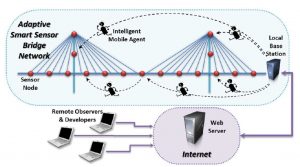 Under this CAREER program, a cyberinfrastructure enabled, dynamically reconfigurable smart sensor framework will be created based on mobile agents. These are the software programs that traverse the wireless sensor network and act intelligently to facilitate network and sensor functionality in response to changes in the bridge loading and response. To realize the full benefits of the bridge monitoring framework, there should be a link between the data it produces and effective bridge management decisions. This link will be pursued by coupling extreme event data with advanced bridge response and windstorm phenomena simulation tools to enable the development of accurate coastal bridge reliability models.
Under this CAREER program, a cyberinfrastructure enabled, dynamically reconfigurable smart sensor framework will be created based on mobile agents. These are the software programs that traverse the wireless sensor network and act intelligently to facilitate network and sensor functionality in response to changes in the bridge loading and response. To realize the full benefits of the bridge monitoring framework, there should be a link between the data it produces and effective bridge management decisions. This link will be pursued by coupling extreme event data with advanced bridge response and windstorm phenomena simulation tools to enable the development of accurate coastal bridge reliability models.
Sunshine Skyway Bridge Monitoring System: Phase I
(with Dr. Justin Davis, University of Florida)
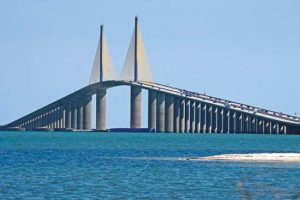 The Sunshine Skyway Bridge, spanning the main entrance to Tampa Bay, is considered one of the flagship bridges in the State of Florida. Since its opening in 1987, the Florida Department of Transportation (FDOT) has implemented several approaches to monitor the bridge’s motion and environmental conditions that have either been short term or limited in functionality. With advances in monitoring technology and data management/visualization, the FDOT recognizes the need for a state-of-the-art, continuous, and fully integrated monitoring system to inform enhanced maintenance and safety decision making.
The Sunshine Skyway Bridge, spanning the main entrance to Tampa Bay, is considered one of the flagship bridges in the State of Florida. Since its opening in 1987, the Florida Department of Transportation (FDOT) has implemented several approaches to monitor the bridge’s motion and environmental conditions that have either been short term or limited in functionality. With advances in monitoring technology and data management/visualization, the FDOT recognizes the need for a state-of-the-art, continuous, and fully integrated monitoring system to inform enhanced maintenance and safety decision making.
The objectives of this Phase I project are to (1) fully assess the condition and challenges of the existing monitoring sensors installed on the Sunshine Skyway Bridge, (2) engage all stakeholders to determine the intent of the currently installed hardware and the desired features of an upgraded system, and (3) investigate effective methods for collecting, integrating, processing, and using data from the bridge for maintenance and safety decision support. The result of Phase I will be a comprehensive set of recommendations for upgrading the Sunshine Skyway Bridge monitoring system to meet the ongoing needs of the FDOT Skyway maintenance office.
Software-Defined MIMO Radar for Structural Health Monitoring
(with Dr. Changzhi Li, Texas Tech University)
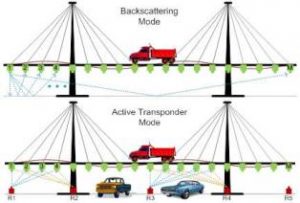 The objective of this research is to resolve significant integration and deployment problems currently limiting structural health monitoring utilizing an innovative multiple-input multiple-output radar-based approach. A software-defined wireless radar sensor network will be devised to monitor structural vibration and deflection with unprecedented accuracy. Passive distributed sensing for low-power data aggregation will also be achieved taking advantage of the multi-input multi-output network. The impacts will be embodied as new capabilities of radar sensor networks for robust structural health monitoring. The approach will be founded on a hybrid fusion of radar solutions, enabled by novel hardware and data processing algorithms. Software configurability will be a driving force in this effort to revolutionize the capability of radar systems while maintaining a compact size. The hardware, software and signal processing innovations will be incorporated to achieve an integrated sensor network system that will be validated in both the laboratory and in a full-scale field deployment.
The objective of this research is to resolve significant integration and deployment problems currently limiting structural health monitoring utilizing an innovative multiple-input multiple-output radar-based approach. A software-defined wireless radar sensor network will be devised to monitor structural vibration and deflection with unprecedented accuracy. Passive distributed sensing for low-power data aggregation will also be achieved taking advantage of the multi-input multi-output network. The impacts will be embodied as new capabilities of radar sensor networks for robust structural health monitoring. The approach will be founded on a hybrid fusion of radar solutions, enabled by novel hardware and data processing algorithms. Software configurability will be a driving force in this effort to revolutionize the capability of radar systems while maintaining a compact size. The hardware, software and signal processing innovations will be incorporated to achieve an integrated sensor network system that will be validated in both the laboratory and in a full-scale field deployment.
Wire Break Detection in Unbonded Tendons for PT Bridges
(with Dr. Trey Hamilton, University of Florida)
Post-tensioned segmental bridges are common throughout the US; however, in recent years, the incidence of tendon failure in bonded post-tensioned bridges has raised questions regarding their design, construction, and maintenance. These failures have led to interest in tendons that are not grouted, but rather filled with a pliable corrosion protection substance such as grease or wax. The use of a flexible filler material in place of cementitious grout results in a replaceable unbonded tendon, which not only affects the structural behavior but also enables the application of new methods for improved monitoring and maintenance. This research focuses on developing an efficient technique for wire breakage detection in unbonded construction. The scope of research includes examining the applicability of existing approaches for tendon monitoring along with developing new approaches that are particularly suitable for unbonded tendons.
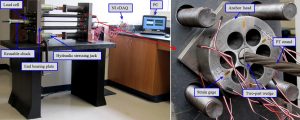 A novel approach has been developed based on relative strain variation in anchors. As large prestressing force results in large strain gradients over the anchors, the strain distribution undergoes significant changes due to a wire break. Based on this strain variation, the project formulates an automated monitoring strategy to characterize the breakage programmatically, as well as conducts a sensitivity study of measurement errors to examine the robustness of the damage detection model. A finite element model of an anchorage assembly and a prestressing strand has been created to conduct a parametric study on the observed strain variations and to examine the stress recovery after wire breaks, respectively. In addition, a large-scale experiment with internal and external tendons has been planned to evaluate the performance of this method in detecting wire breaks
A novel approach has been developed based on relative strain variation in anchors. As large prestressing force results in large strain gradients over the anchors, the strain distribution undergoes significant changes due to a wire break. Based on this strain variation, the project formulates an automated monitoring strategy to characterize the breakage programmatically, as well as conducts a sensitivity study of measurement errors to examine the robustness of the damage detection model. A finite element model of an anchorage assembly and a prestressing strand has been created to conduct a parametric study on the observed strain variations and to examine the stress recovery after wire breaks, respectively. In addition, a large-scale experiment with internal and external tendons has been planned to evaluate the performance of this method in detecting wire breaks
Smart Sensors
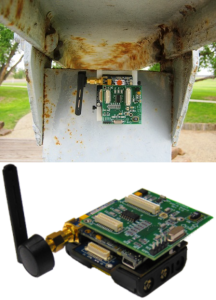 Advances in wireless technology and embedded processing have made low-cost wireless smart sensor networks an attractive alternative to wired data acquisition systems. The majority of the work using wireless sensors for structural monitoring has focused on using the sensor networks to emulate traditional wired sensor systems. As these systems require that all data be sent back to a central processing center, the amount of wireless communication required in the network can become costly in terms of excessive communication times and the associated power that is the network size increases. Wireless smart sensors networks (WSSNs) leverage onboard computational capacity to allow data processing to occur within the network, as opposed to at a central location. By implementing data processing techniques, such as modal analysis or damage detection algorithms, in such a distributed manner, the amount of communication that occurs within the network can be reduced, while providing usable information on the structural condition. WSSNs employing decentralized computing offer a scalable solution that has the potential to dramatically improve structural health monitoring efforts.
Advances in wireless technology and embedded processing have made low-cost wireless smart sensor networks an attractive alternative to wired data acquisition systems. The majority of the work using wireless sensors for structural monitoring has focused on using the sensor networks to emulate traditional wired sensor systems. As these systems require that all data be sent back to a central processing center, the amount of wireless communication required in the network can become costly in terms of excessive communication times and the associated power that is the network size increases. Wireless smart sensors networks (WSSNs) leverage onboard computational capacity to allow data processing to occur within the network, as opposed to at a central location. By implementing data processing techniques, such as modal analysis or damage detection algorithms, in such a distributed manner, the amount of communication that occurs within the network can be reduced, while providing usable information on the structural condition. WSSNs employing decentralized computing offer a scalable solution that has the potential to dramatically improve structural health monitoring efforts.